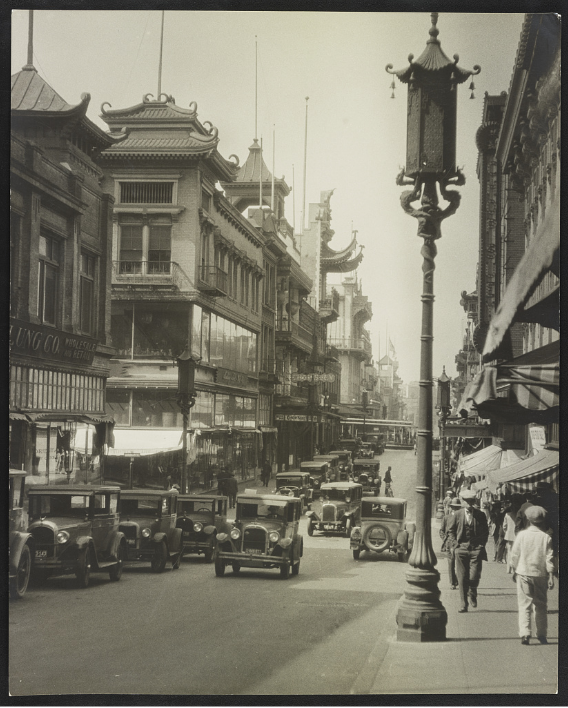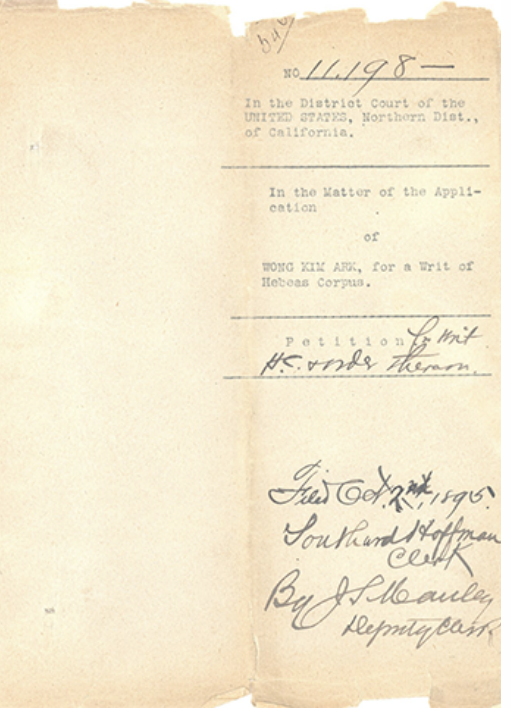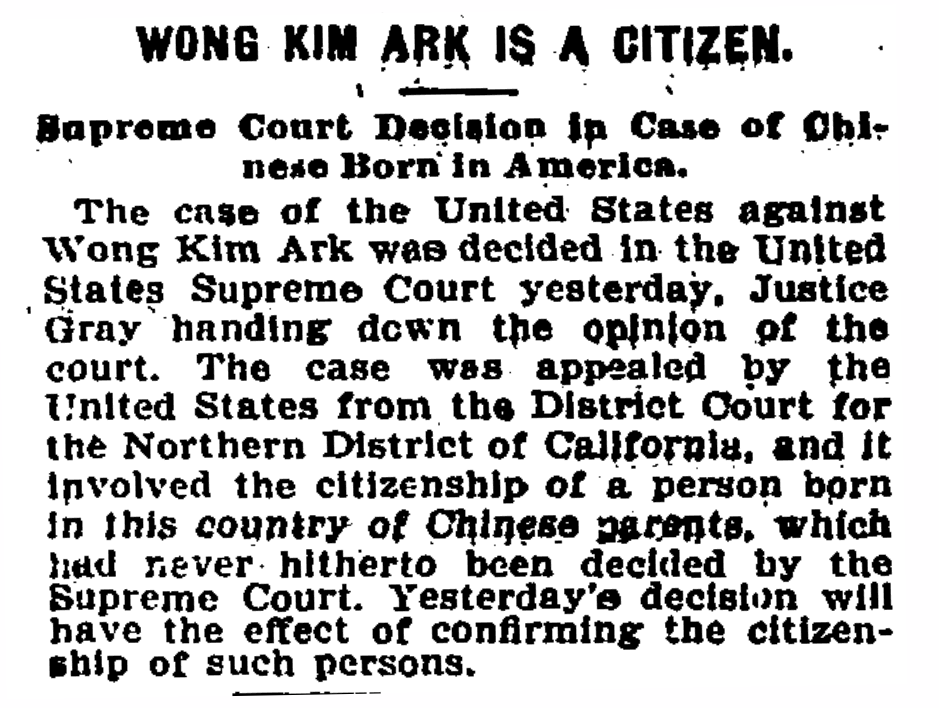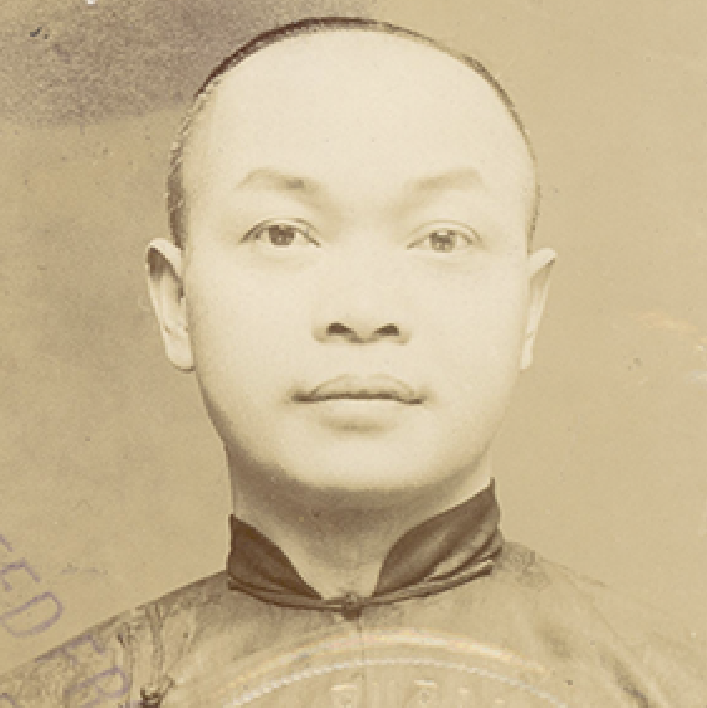Photograph of Wong Kim Ark from a Federal immigration investigation case conducted under the Chinese Exclusion Acts (1882–1943).
DocsTeach, National Archives (Public Domain)
Grade: 2-6Subject:
U.S. History, Social Studies, English Language Arts
Number of Activities: 4+ Extension Activities
Wong Kim Ark was born in San Francisco, California, in 1873 to Chinese immigrant parents. In 1894, Wong traveled to China to visit his parents who had moved back to China. When he returned to the United States, Wong was denied re-entry. His denial was based on the grounds that he was not a U.S. citizen due to the Chinese Exclusion Act of 1882. Wong took his case to court. He argued that because he was born in the United States, the Citizenship Clause of the Fourteenth Amendment made him a citizen. The Supreme Court ruled in favor of Wong. This case effectively established birthright citizenship in the United States. In this lesson, students will learn about the life and legacy of Wong Kim Ark and his role in redefining citizenship in the United States.
Students will:
- Identify Wong Kim Ark’s contributions to the United States.
- Define birthright citizenship.
Wong Kim Ark and Birthright Citizenship (Elementary) Essay:
Wong Kim Ark (circa 1873-1950*) was born in San Francisco, California, in 1873. He was born to Chinese
immigrant parents. During this time, the United States was going through a
depression. Many people lost their jobs and blamed Chinese immigrants for taking them. Because of this, Chinese immigrants were targeted with hate and violence. As a result of anti-Asian hate, the U.S. government passed the
Chinese Exclusion Act of 1882. This law banned people from China and Asia moving to the United States.
Life was difficult in the United States. Chinese people were treated poorly. The Chinese Exclusion Act made things worse. The shop that Wong’s parents owned was not doing well. So, they moved back to China. Meanwhile, Wong stayed in San Francisco. He worked as a cook. In 1894, Wong visited his parents in China. When he returned to the United States, he was not allowed to re-enter the country. Immigration officers claimed he was not a U.S.
citizen because of the Chinese Exclusion Act. For months, Wong was
detained on the ships at San Francisco Bay.
Wong decided to fight for his rights. He took his case to the
Supreme Court. In March 1897,
hearings of the case
United States v. Wong Kim Ark (1898) began. Wong argued that he was a citizen because he was born in the United States. In 1898, Wong won his court case. This established
birthright citizenship in the United States.
Birthright citizenship is a
right that allows people to become citizens of the country in which they are born. Because of Wong,
generations of immigrants are able to live and raise their families in the United States. Today, many immigrant communities, including Asian Americans, who became citizens through birthright citizenship are able to vote, go to college, and more. Today, Wong Kim Ark is known as an Asian American
pioneer. Even though there are people who
disagree with birthright citizenship and have tried to end it, many others continue to fight for their rights and protect his
legacy.
* Exact years unknown. Various sources list 1870-1873 for birth; year of death unknown.
Bibliography:
- birthright citizenship: the legal principle that anyone born within a country’s territory is a citizen upon their birth2
- Chinese Exclusion Act of 1882: a law that placed a 10-year ban on Chinese immigration to the United States; the Chinese Exclusion Act was in effect until 19433
- citizen: a person who lives in or is a member of a country and is protected by it
- depression: a period of low general economic activity with widespread unemployment
- detain: to hold or keep in, as if in prison
- disagree: to have a different opinion
- generation: a group of people in the next line of descent from an ancestor
- hearing: an opportunity to present arguments in a court case
- immigrant: a person who permanently moves to a country
- legacy: long-lasting impact
- pioneer: a person who starts something significant and makes a difference in the world
- right: a privilege that a person has that is protected by the law
- Supreme Court: the highest court in the nation
- Who is Wong Kim Ark? Why is he important?
- What did you learn about Wong Kim Ark’s life?
- Why were Chinese immigrants targeted with hate and violence in the 1870s?
- How did the Chinese Exclusion Act of 1882 impact Wong Kim Ark’s family?
- How did Wong Kim Ark fight for his rights?
- How did Wong Kim Ark’s case affect other immigrants?
- In what ways is Wong Kim Ark a pioneer?
- What is Wong Kim Ark’s legacy?
- Why is it important to protect Wong Kim Ark’s legacy?
Activity 1: Defining Citizenship
- Ask students, “What do you know about citizenship? What does it mean to be a citizen?” Have students volunteer to share their responses.
- Tell students the following statement: “A citizen is a member of a country. Countries all around the world practice citizenship in different ways. Let’s learn more about ways to become a U.S. citizen and the rights and responsibilities of U.S. citizens.”
- Suggested for upper grades: Show students the video entitled, “The Rights & Responsibilities of U.S. Citizen | Politics on Point” by NewsDepth. Facilitate a discussion by asking the following questions:
- What rights do U.S. citizens have?
- What responsibilities do U.S. citizens have?
- What are different ways people can become U.S. citizens?
- Suggested for lower grades: Show students the video entitled, “Becoming a Citizen | ARTHUR” by PBS Learning Media. Facilitate a discussion by asking the following questions:
- How did Cheikh’s parents become U.S. citizens?
- How did Cheikh become a U.S. citizen?
- How did Arthur, D.W., and Buster become U.S. citizens? Why didn’t they need to take a test like Cheikh’s parents?
- What are some things that Cheikh and his parents can do after becoming U.S. citizens?
- Tell students the following statement: “One of the ways people in the United States can become citizens is through birthright citizenship. Birthright citizenship is a rule that allows children who are born in the United States to automatically become citizens. This rule was established because of Wong Kim Ark, a Chinese American who fought for his rights as a birthright citizen.”

“Street in Chinatown, San Francisco, California” in the early 1900s. Wong Kim Ark was born in San Francisco Chinatown in 1873.
Credit: Photographer: Arnold Genthe (1869-1942). Library of Congress (No known restrictions on publication)
Activity 2: Summarizing the Significance of Wong Kim Ark
- Show students a picture of Wong Kim Ark (Source: DocsTeach). Ask students if they have heard of Wong Kim Ark. Have students share any prior knowledge about Wong Kim Ark.
- Have students read the “Wong Kim Ark and Birthright Citizenship Essay.” (Option: Create a slide deck with the essay content).
- Facilitate a class discussion by asking students the Discussion Questions.
- Hand out a copy of the worksheet entitled, “Fact Finder” to each student. Have students read the essay again and complete the worksheet.
- Have students identify and record significant facts that resonated with them in the “Fact Description” column. Have students record one fact per row.
- Have students confirm the source of each fact in the “Source” column by checking the “Essay” column.
- Show students the video entitled, “Wong Kim Ark’s Fight for Birthright Citizenship" by Untold History.
- Ask students the following questions:
- What other facts did you learn about Wong Kim Ark?
- Why is Wong Kim Ark important?
- Have students review the facts they have already listed on the worksheet entitled, “Fact Finder.” Have them check the “Video” column if the fact was confirmed in the video.
- Have students record additional facts they learned from the video and check the “Video” column.
- Read aloud the story, I Am an American: The Wong Kim Ark Story by Grace Lin and Martha Brockenbrough.
- Ask students, “What more did you learn about Wong Kim Ark from the story?”
- Have students review the facts they have already listed on the worksheet entitled, “Fact Finder.” Have them check the “Book” column if the fact was confirmed in the book.
- Have students record additional facts they learned from the book and check the “Book” column.
- Facilitate a discussion by asking the following questions:
- Which facts are consistent across all three sources? What does this mean?
- Which facts are not consistent across all three sources? What accounts for these inconsistencies?
- Have students write an explanatory/informative paragraph answering this prompt: “What significant role did Wong Kim Ark play in U.S. history?”
- Have students write an introductory statement.
- Have students include three facts they learned about Wong Kim Ark that support their introductory statement.
- Have students write a concluding statement.

“Application of Wong Kim Ark for Writ of Habeas Corpus.” This application was submitted on behalf of Wong Kim Ark in October 1895, after Wong was detained when he returned to San Francisco following a trip to China.
Credit: DocsTeach, National Archives (Public Domain)
Activity 3: Analyzing a Primary Source
- Display the primary source document entitled, “Application of Wong Kim Ark for Writ of Habeas Corpus (10/18985)” (Source: DocsTeach).
- Read students the title of the document.
- Explain the following: “A ‘writ of habeas corpus’ is a court order telling a public official who is detaining someone that they must bring the person being detained to court and show the legal reason they are holding that person. Writ refers to a formal written document, and habeus corpus means ‘you have the body’ in Latin.”
- Have students look for identifying information such as a maker, date, place of origin, and intended audience.
- Tell students the following: “This document is an application for the writ of habeas corpus on behalf of Wong Kim Ark. It was created in 1895 when he returned from China and was not allowed to re-enter the United States, and was instead detained.”
- Read aloud page 2 of the document.
- Have students restate and summarize page 2 of the document in their own words. Record student responses for all to see.
- Facilitate a discussion by asking the following questions:
- Why is this document important?
- How does this document help us understand Wong Kim Ark’s story?
- How might this document have been helpful to Wong in bringing his case to court?

This news story from The Washington Post shares the decision in the Supreme Court case United States v. Wong Kim Ark (1898).
Credit: The Washington Post, March 29, 1898. (Public Domain)
Activity 4: Honoring Wong Kim Ark’s Legacy
- Show students the video entitled, “Birthright Citizenship and Wong Kim Ark” by 1990 Institute. Facilitate a discussion by asking the following questions:
- What is Wong Kim Ark’s legacy?
- How did Wong Kim Ark make a difference in American society?
- Why is birthright citizenship an important accomplishment in the United States?
- How did Wong Kim Ark show what it means to fight for your rights?
- How did Wong Kim Ark define what it means to be an “American”?
- Show students the video entitled, “Chinatown mural depicts 12 AAPI community heroes.”
- Tell students the following: “The mural in the video is located in San Francisco Chinatown. It honors Asian American pioneers and heroes including Wong Kim Ark.”
- Show students the webpage entitled, “Asian American Community Heroes Mural” and have students observe the mural more closely.
- Facilitate a discussion about the mural/video by asking the following questions:
- Why was Wong Kim Ark included in the mural?
- Why is it important to honor Wong Kim Ark’s legacy?”
- Have students make a creative project to honor Wong Kim Ark’s legacy (i.e., design a mural, write a book, create a video, design a plaque, etc.). Have students write a paragraph explaining how their project honors Wong Kim Ark.
- Have students create a short video about Wong Kim Ark that includes the following:
- At least three facts about Wong Kim Ark’s life
- At least two challenges that Wong Kim Ark faced
- At least one way that Wong Kim Ark made a difference in society
- Have students research one of the other Asian American heroes shown on the “Asian American Community Heroes Mural.” Have students write a report about the hero they selected or have them write about a hero in their community.
- Have students imagine they are a journalist and have an opportunity to interview Wong Kim Ark. Have students choose one of the following significant events in Wong’s life, and write a list of questions they would ask him about the event:
- Wong Kim Ark’s parents moving back to China
- Wong Kim Ark working as a cook in Chinatown
- Wong Kim Ark being detained in San Francisco Bay
- Wong Kim Ark at his case hearing
- Wong Kim Ark life after the ruling of United States v. Wong Kim Ark
- Have students write a thank you letter to Wong Kim Ark. Have students explain what birthright citizenship means to them.
- Show students the video entitled, “Book Chat with the Illustrator featuring Julia Kuo on I AM AN AMERICAN” by Little Brown School and Library. Have students write a reflection on what they learned about Julia Kuo’s experience illustrating the book, I Am an American: The Wong Kim Ark Story.
1990 Institute. “History Makers: Wong Kim Ark fought for his right to citizenship leading to a landmark decision of U.S. birthright citizenship for all.”
Instagram, 4 February 2025.
https://www.instagram.com/p/DFqroG0znQA/.
Lin, Grace and Martha Brockenbrough. (2021). I Am an American: The Wong Kim Ark Story. Little Brown and Company, 2021.
College, Career, and Civic Life (C3) Framework for Social Studies State Standards
D2.His.3.K-2.
Generate questions about individuals and groups who have shaped a significant historical change.
D2.His.3.3-5.
Generate questions about individuals and groups who have shaped significant historical changes and continuities.
D2.His.11.K-2.
Identify the maker, date, and place of origin for a historical source from information within the source itself.
D2.His.11.3-5.
Infer the intended audience and purpose of a historical source from information within the source itself.
Common Core State Standards: English Language Arts Standards » Grade 2-5
CCSS.ELA-Literacy.RI.2.3
Describe the connection between a series of historical events, scientific ideas or concepts, or steps in technical procedures in a text.
CCSS.ELA-Literacy.RI.3.3
Describe the relationship between a series of historical events, scientific ideas or concepts, or steps in technical procedures in a text, using language that pertains to time, sequence, and cause/effect.
CCSS.ELA-Literacy.RI.4.3
Explain events, procedures, ideas, or concepts in a historical, scientific, or technical text, including what happened and why, based on specific information in the text.
CCSS.ELA-Literacy.RI.5.3
Explain the relationships or interactions between two or more individuals, events, ideas, or concepts in a historical, scientific, or technical text based on specific information in the text.
National Council for the Social Studies Standards
Civic Ideals and Practices -
Learning how to apply civic ideals as part of citizen action is essential to the exercise of democratic freedoms and the pursuit of the common good. Students acquire a historical and contemporary understanding of the basic freedoms and rights of citizens in a democracy, and learn about the institutions and practices that support and protect these freedoms and rights, as well as the important historical documents that articulate them.





